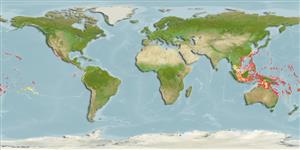>
Gobiiformes (Gobies) >
Gobiidae (Gobies) > Gobiinae
Etymology: Eviota: No etymology given, suggested by Christopher Scharpt: from Latin 'eu' for 'true' and 'iota' for anything very small, in combination 'truly very small' referring to it as being the smallest vertebrate at the time it has benn described by Jenkins (thus, making the suggestion by Scharpt plausible..
More on authors: Jordan & Seale.
Environment: milieu / climate zone / depth range / distribution range
Ecología
marino asociado a arrecife; rango de profundidad 0 - 40 m (Ref. 107299). Tropical; 30°N - 30°S
Western Pacific: Japan (Ryukyu and Ogasawara islands), Taiwan, the Philippines and south to Australia and Norfolk Is.; east to Vanuatu, Fiji, Wallis and Futuna, Tonga and Samoa, including Palau, Guam and Marshall Islands in Micronesia.
Tamaño / Peso / Age
Maturity: Lm ? range ? - ? cm
Max length : 2.3 cm SL macho / no sexado; (Ref. 1602)
Short description
Claves de identificación | Morfología | Morfometría
Espinas dorsales (total) : 7; Radios blandos dorsales (total) : 8 - 9; Espinas anales: 1; Radios blandos anales: 7 - 8. This species is distinguished by the following characters: complete cephalic sensory-canal pore system (pattern 1); the fifth pelvic-fin ray 10-40% (usually 20%) of fourth ray; some pectoral-fin rays are branched; dorsal/anal-fin formula 9/8; presence of a prominent occipital spot; dorsal midline of body with a series of small dark spots along the dorsal-fin bases; dark bars present crossing the nape in advance of dorsal fin; caudal-peduncle depth 13.4-14.9% SL (Ref. 107299).
Inhabits shallow waters, often including tide pools of exposed seaward reefs (Ref. 37816, 116739), usually in high-tide splash zones and at shallow depths (Ref. 107299).
Life cycle and mating behavior
Maturities | Reproducción | Spawnings | Egg(s) | Fecundities | Larva
Myers, R.F., 1991. Micronesian reef fishes. Second Ed. Coral Graphics, Barrigada, Guam. 298 p. (Ref. 1602)
IUCN Red List Status (Ref. 130435)
Threat to humans
Harmless
Human uses
Pesquerías: sin interés
Herramientas
Special reports
Download XML
Fuentes de Internet
Estimates based on models
Preferred temperature (Ref.
123201): 24.7 - 29.3, mean 28.3 °C (based on 1537 cells).
Phylogenetic diversity index (Ref.
82804): PD
50 = 0.5000 [Uniqueness, from 0.5 = low to 2.0 = high].
Bayesian length-weight: a=0.01023 (0.00477 - 0.02194), b=3.02 (2.84 - 3.20), in cm total length, based on LWR estimates for this (Sub)family-body shape (Ref.
93245).
Nivel trófico (Ref.
69278): 3.1 ±0.3 se; based on size and trophs of closest relatives
Resiliencia (Ref.
120179): Alto, población duplicada en un tiempo mínimo inferior a 15 meses (Preliminary K or Fecundity.).
Fishing Vulnerability (Ref.
59153): Low vulnerability (10 of 100).
Nutrients (Ref.
124155): Calcium = 374 [160, 1,182] mg/100g; Iron = 1.74 [0.76, 3.78] mg/100g; Protein = 18 [16, 20] %; Omega3 = 0.175 [0.057, 0.516] g/100g; Selenium = 33.1 [10.6, 89.5] μg/100g; VitaminA = 121 [25, 572] μg/100g; Zinc = 4.49 [2.47, 7.46] mg/100g (wet weight);
